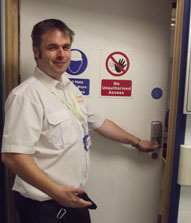At University Hospital Southampton, which has 9500 employees, supervisors of locksmiths working in the estates building maintenance department, Eamonn Devaney, pictured, and Ron Bran, and team need to control the movement of thousands of people on campus and keep the hospital running at the same time.
To help deter unauthorised entry to restricted areas, the estates building maintenance use a mix of access control products including locks and keys, hard-wired systems requiring RFID cards and readers, as well as standalone mechanical and electronic digital locks. The products help create physical barrier, while at same time allowing authorised personnel to go about their daily routine.
Managing room keys and access cards for hard-wired systems on a large scale can be a problem. With such numbers of staff working at the hospital, some will get lost or stolen. The time taken to manage the issue of new and replacement keys and cards can be considerable, but it’s essential to maintain security. Because cost is such an important factor when considering which access control products to use for new buildings or refurbishments, it’s not always possible to extend use of hard-wired systems. Sometimes it’s more cost effective to look at a standalone solution, and this is where the use of digital door locks can provide advantages.
Digital locks can be installed one door at time without impacting other systems. There are no keys or cards to issue; instead staff members are given an access code to get through the door. Access codes can be changed on a regular basis to help prevent codes from being passed on or misused. Digital locks are mechanically or electronically operated. The estates building maintenance team use hundreds of mechanical and electronic door locks all over campus to give access protection to areas such as treatment rooms, offices and laboratories.
The main advantage of electronic door locks over their mechanical counterparts is their ability to provide more functions. With electronic digital locks, more code combinations are available, the locks will shut down temporarily after three incorrect code attempts and code changes can be made via the keypad. Now, some electronic door locks facilitate PC-based programme control and audit trail; previously only card-based access control systems could provide this.
At Southampton, the estates building maintenance team is trialling eight new digital electronic locks with audit trail from Codelocks. One of the challenges the team faces is the ability to protect supplies, equipment and machinery. Access protection is needed to deter theft and damage to property, which disrupt the running of the hospital.
The hospital employs contractors to manage the building’s services, and the contractors’ engineers need regular access to rooms containing plant and machinery. Using the Codelocks’ CL5010 tubular mortice-latch locks with audit trail and accompanying software, the team can allocate time-sensitive access codes to plant room doors. The codes will only work for the hours the engineer is contracted; they will not work outside this timeslot. The digital locks record all of the access codes used in an audit trail log, which can be downloaded using a USB memory stick and analysed using the data management software. This tells who’s been through each door and when. The locks also register incorrect code attempts, so if someone is trying to get access out of hours, they will know.
Estates building maintenance can create up to 900 access codes, allocating an engineer’s name against each code. To save time, lock settings can be copied from one lock to another and the new settings uploaded via the USB stick. Visit www.codelocks.co.uk.










